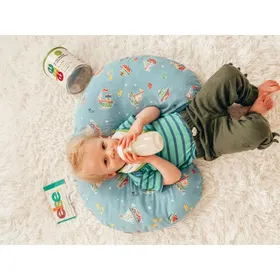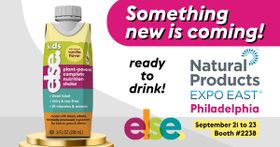Why Infants and Children are More Vulnerable to Ingested Toxins – and How to Protect Them
Concerned about toxins in your child's food? Explore the risks of heavy metals in baby foods and find tips for choosing safer, healthier options for your little ones.
Published August 8, 2024

When hearing the words ‘heavy metals’ and ‘toxins’, one might associate them with our living environment, like old water pipes, lead paint, and pollutants in the air we breathe. But more recently, those terms have entered our common lingo when we talk about food—more specifically, foods for infants and children.
As parents and caretakers become more educated and aware of what exactly is in their children’s foods, many baby food manufacturers have had to come ‘clean’ on what toxins and contaminants might actually be lurking in their products.
In February 2021, the U.S. Congress released a report that found dangerously high levels of toxic heavy metals—including inorganic arsenic, lead, cadmium, and mercury—in 95% of the baby foods tested. These foods are produced by some of the largest baby food manufacturers in the U.S., some of which even produce organic products. Many parents rely on these companies to feed and nourish their children daily.
» Choose organic, plant-based nutrition free from harmful toxins and designed for healthy growth
The Importance of Addressing High Levels of Toxins in Infant and Children's Foods
Infants and children are some of the most vulnerable members of the population in many aspects, especially when it comes to the effects of ingested toxins. Children are developmentally not equal to ‘small adults’. They are at higher risk of exposure to environmental toxins, compared to most adolescents and adults, due to many reasons, including:
» Here's how to reduce your kid's exposure to toxins through diet
1. Proximity to the Ground
Infants and toddlers often lie on the ground or crawl and are shorter in height. Thus they are closer physically to chemicals and toxins commonly found on the ground indoors and out.
2. Smaller Body Size
Relative to their body size and weight, infants and children consume a larger amount and concentration of air, food, and water than adults, leading to potentially greater exposure.
3. Higher Surface Area to Volume Ratio
Due to their smaller body size, infants and children have a larger body surface area than adults. Thus, they are at risk of greater exposure to and absorption of chemicals and toxins.
4. Developing Brain and Vital Organs
Infants and children have fewer defense mechanisms against environmental toxins and chemicals. In the first years of life, the vital organs and the brain are developing rapidly and are more sensitive to potential damage caused by exposure.
» Find out how to support your child's healthy development by prioritizing nutrition in their first 1000 days
5. Inability to Distinguish Food vs. Non-Food Objects
Infants and children, out of curiosity and simply habit, love to put things in their mouths regardless of whether they are safe or edible. For instance, chips of lead paint actually have a sweet flavor, making them even more attractive for infants to put into their mouths.
6. A Less Varied Diet
Infants and children tend to eat diets containing less variety of foods, and this can also be due to a more limited range of food preferences. Typical foods that many children eat early on, such as rice and fruit purees or juices, may contribute to exposure to heavy metals.
» Discover how to create a balanced diet for your kid
7. Unique Exposures Associated With a Location
Infants and children may spend a lot of time at school, nurseries/daycare, and outdoor playgrounds, all of which pose a risk of exposure to different environmental toxins unique to this population.
Understanding the Risks and Need for Transparency
The World Health Organization (WHO) and Food and Drug Administration (FDA) have declared toxic heavy metals as harmful to human health, and even low levels of exposure can cause serious and irreversible damage to the developing brain of an infant or child. These heavy metal toxins include inorganic arsenic, lead, cadmium, and mercury. There is scientific evidence to show that these substances pose dangers to a developing infant or child, particularly to the detriment of their growth, cognitive performance, and behavioral development.
According to the 2021 Congressional reports, the majority of baby food manufacturers in the U.S. test only their ingredients, not the final products. This can be a source of misinformation and distrust for consumers who are buying these products for their children without full knowledge of what they may contain. Consumers need full access to information in order to make properly informed decisions.
» Here's what to look for and avoid in baby formula ingredients for your child's health
How Can Concerned Parents Safeguard Their Children's Health Amidst Brand Transparency Issues?
With food safety at the forefront of many parents’ minds, there are several companies taking the ‘clean’ approach and aiming to differentiate themselves from the rest in the industry. One of the ways brands do this is through the Clean Label Project certification.
Clean Label Project is a non-profit organization that advocates for transparency in the production and labeling of consumer products through its certification program. Brands and products certified by CLP go through rigorous laboratory testing for levels of heavy metals, pesticides, plasticizers, BPA, phthalates, acrylamide, and others. Parents can choose to purchase from products that are CLP-certified.
Additionally, the Clean Label Project conducted its own study of over 530 of the most commonly purchased baby and toddler food products. Their findings included:
- About 65% of baby food products contained some arsenic.
- 36% of baby food samples had detectable levels of lead.
- 60% of the products labeled “BPA-free” tested positive for BPA.
- “Certified organic” baby foods had higher levels of arsenic than conventional foods (although tested for lower levels of pesticide residues).
In the meanwhile, to decrease infants’ or children’s exposure to store-bought products, parents can do the following:
- Opt out of purchasing from brands that do not take the extra steps.
- Avoid or lessen the number of foods or ingredients that naturally tend to be higher in certain toxins while opting for more variety.
- Support businesses that promote transparency and take extra precautionary measures.
» Choose Else for your child's nutrition—our products prioritize safety and transparency with clean, organic ingredients.
Making Informed Choices
As awareness grows about the presence of toxic heavy metals in baby foods, it's crucial for parents and caregivers to take proactive steps to safeguard their children's health. By choosing products from brands committed to transparency and safety, opting for a more varied diet, and staying informed about potential risks, we can minimize exposure to harmful substances.
The health and well-being of our children depend on the choices we make today—let’s ensure we’re making informed and responsible ones.
References
- Clean Label Project
- PubMed
- House Committee on Oversight and Reform
- Consumer Reports: Product Reviews and Ratings
- Healthy Baby Food
- Parents - Pregnancy, Birth, Babies, Parenting
- One Green Planet
The content and advice provided in this article are for informational purposes only and are not a substitute for medical diagnosis, treatment, or advice for specific medical conditions. Always consult a pediatrician to understand the individual needs of your child.









